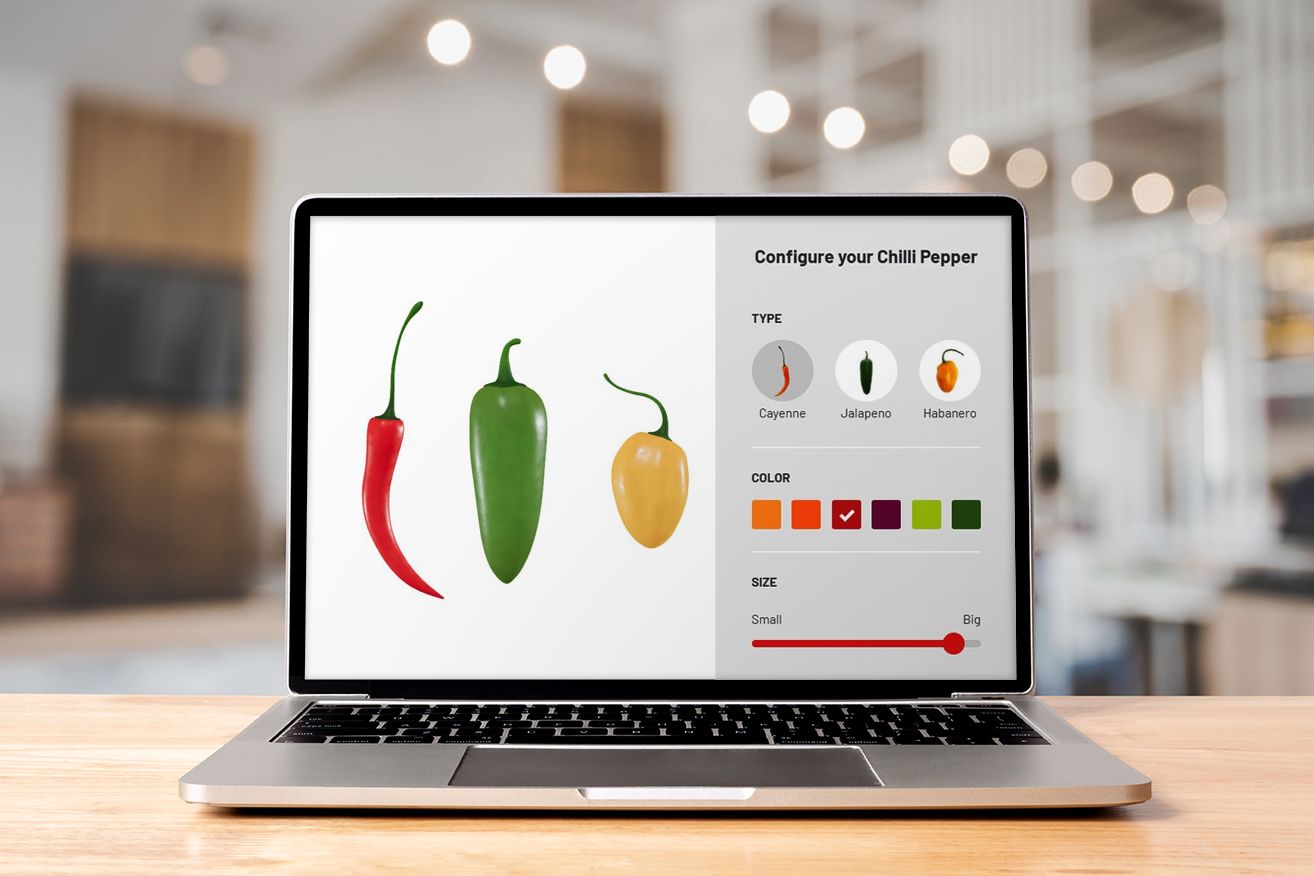
10 Hidden Pitfalls of 3D Configurator Implementation and 10 Questions to Uncover Them (Pay Attention to #3!)
In this article, we discuss the pitfalls to avoid and the essential considerations when implementing 3D configurators.
Table of Contents
The complexity of 3D product configurators, with their vast array of features, poses significant challenges that could trap the unprepared. Before plunging into the selection process, it's essential to fully understand the needs of your business, evaluate the granularity of details required, and assess the available resources for implementation.
A Deloitte study reveals that a striking 34% of customers find standard products and services unsatisfactory, pointing towards a strong appetite for customization. The right 3D product configurator, catering to your unique catalog size, configuration requirements, and scalability needs, can quench this thirst for tailored solutions.
Data-driven features and a solid rules engine are vital for managing large product catalogs and complex configurations. Incorporation with existing pricing, shopping cart, quote request, and order features is also an important consideration.
But how do you navigate this complex process? What are the pitfalls to avoid? And what inquiries should you make before taking the plunge into 3D product configurator implementation?
This article seeks to uncover the hidden snags and guide you on your journey to 3D product configurator implementation.
Request Free Consultation
Submit this form and we will contact you back to schedule the free consultation.
How to Avoid Common Implementation Pitfalls with 3D Configurators
Implementing a 3D product configurator is undoubtedly a valuable investment. However, it is essential to understand and steer clear of potential pitfalls that may arise during the implementation process. Let's take a closer look at some of these challenges and the data-backed strategies to overcome them:
- Lack of clear goals: Embarking on a 3D configurator project without a clear understanding of your objectives can lead to ineffective outcomes.
- No KPIs or benchmarks: Without proper key performance indicators (KPIs) and benchmarks, it becomes challenging to measure the effectiveness of your configurator and make improvements.
- Overlooking configurator features: The range of features offered by a 3D configurator, such as parametric models, drag and drop functionality, Augmented Reality (AR), or nested configurators, can significantly impact its usability and customer experience. It's crucial to evaluate your specific use case and requirements to determine which features are essential for your success.
- Inadequate team structure: Building and managing a competent team to handle the configurator is vital for seamless operations. This includes having skilled personnel like 3D model designers who can create and optimize product models for the configurator.
- Neglecting delivery channels: Understanding how customers will interact with the configurator across various platforms is crucial.
- Ignoring dynamic pricing options: If dynamic pricing is a part of your strategy, establishing pricing rules for each product element or modification is essential.
- Lack of technical compatibility: Ensuring that the configurator's underlying technology can seamlessly integrate with your existing systems is critical for a smooth implementation.
- Overlooking SKU complexity: If your products involve multiple options and variants, it is crucial to choose a configurator that can handle the complexity.
- Ignoring rendering complexities: The complexity of your products can impact the performance and rendering capabilities of the configurator. It's essential to choose a solution that can effectively handle the rendering requirements of your specific products.
- Neglecting eCommerce integrations: Seamlessly integrating the configurator with your eCommerce platforms, such as Shopify, Salesforce, or WooCommerce, is vital for a streamlined sales process.
By avoiding these common pitfalls and leveraging the data-backed strategies mentioned above, you can successfully implement a 3D product configurator to transform your customer experience. A good 3D Configurator provides a reliable solution tailored to your enterprise needs. It should seamlessly integrates with your existing enterprise products and eCommerce websites. This integration enables you to boost sales, increase engagement, reduce returns, and gain valuable insights into customer preferences for enhanced personalization and innovation.

Data from industry studies consistently highlight the positive impact of a well-implemented 3D product configurator. Businesses that adopt configurators often witness significant improvements, such as:
- Increased sales: Configurators empower customers to visualize and customize products according to their preferences, leading to higher purchase intent and conversion rates. Studies show that businesses implementing configurators can experience up to a 30% increase in sales.
- Reduced product returns: By allowing customers to interact with and personalize products in a virtual environment, configurators help manage expectations and minimize dissatisfaction. This results in a decrease in product returns and associated costs, contributing to higher profitability.
- Enhanced customer engagement: The interactive nature of 3D product configurators captivates customers and fosters deeper engagement. This immersive experience increases the time spent on websites and strengthens the emotional connection to the brand, leading to improved customer loyalty.
- Improved personalization: Configurators enable businesses to gather valuable data on customer preferences and choices. By analyzing this data, companies can offer tailored recommendations and personalized experiences, which are highly valued by today's consumers.
- Driving innovation: The insights gained through configurator usage provide valuable feedback for product development and innovation. Businesses can identify popular configurations, emerging trends, and customer preferences, empowering them to create new offerings that resonate with their target market.
In conclusion, the implementation of a 3D product configurator presents both opportunities and challenges. By being aware of the common pitfalls and leveraging data-backed strategies, businesses can navigate the implementation process successfully. Salsita 3D Configurator stands as a reliable solution, supported by its MACH-compliant architecture, seamless integration capabilities, and tailored approach. It is designed to empower businesses to unlock the full potential of configurators and capitalize on the transformative benefits they offer.

10 Must-Ask Questions to Ensure Success with Your 3D Configurator
Equipping yourself with the right questions can be the difference between selecting a 3D product configurator that boosts your business or one that doesn’t fit your needs. Here are some crucial inquiries to make:
- What is the underlying technology? Ensure it offers flexibility and isn’t limited to a single platform.
- Which platforms does it need to integrate with? Integration with existing applications, such as ERP, CRM, CMS, PIM, and eCommerce store, is crucial.
- Does it support configurable SKUs? This is vital for tracking your inventory and differentiating between products.
- How many options does it offer for each SKU? If your product has many custom features, having multiple options is essential.
- How complex are the dependencies between options? The configurator should be able to handle the rules, dependencies, and complexities of your products.
- Will 3D models need to be created? If you don’t have in-house designers, you’ll need to get them modeled.
- Are existing 3D models high quality? The visual appeal and impact of your configurator are determined by the quality of your images.
- Is your product easy to render in 3D? The complexity of the product can affect the performance of the configurator.
- Which eCommerce integrations does the configurator offer? This is crucial for simplifying the hand-off process to manufacturing.
- Do you need additional features? This could include enabling multiple languages and currencies, AR capabilities, and manufacturing documentation.
By considering these questions and potential pitfalls, you can embark on your journey to implementing a 3D product configurator with confidence. Leveraging tools like Salsita 3D Configurator can ensure that you not only navigate these pitfalls effectively but also harness the true power of 3D product customization, leading to enhanced customer experiences and ultimately, a stronger bottom line.
Embrace the Future of DTC eCommerce with 3D Configurators
The power of 3D product configurators lies not just in the interactive customer experience they offer, but also in their potential to drive sales, increase customer engagement, and reduce product returns. By understanding customer preferences through the configurator, businesses can achieve better personalization and innovation, factors that are increasingly critical in the digital age.
Investing in a 3D product configurator is not just about adding a high-tech feature to your online store. It's about enhancing the shopping experience for your customers and providing them with a level of interaction and personalization that today's consumers crave. With the correct choice of configurator and a well-planned implementation, businesses can not only meet but exceed customer expectations, paving the way for a successful future in the eCommerce world.
If you're ready to embark on the journey of implementing a 3D product configurator and want to explore how it can drive growth for your business, contact us today for a free consultation. Our experienced team will guide you through the process, ensuring a customized and successful implementation that aligns with your specific goals and requirements. Take the first step towards revolutionizing your customer experience and maximizing your business potential with the Salsita 3D Configurator.
Request Free Consultation
Submit this form and we will contact you back to schedule the free consultation.
Contact us today for a free consultation and discover how our cutting-edge solution can propel your business forward.










